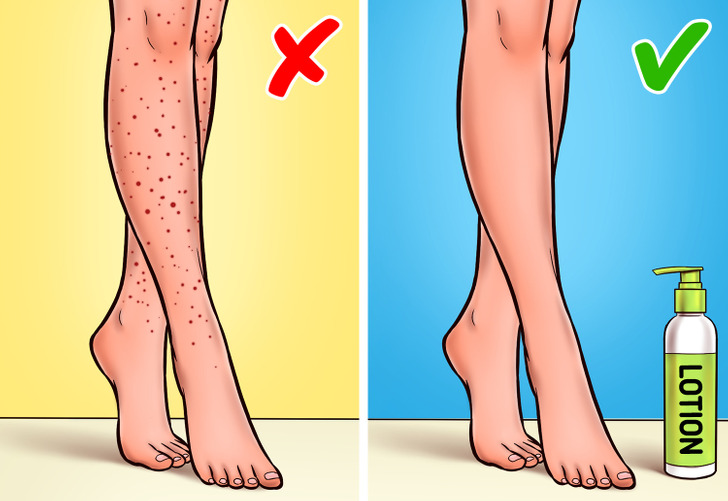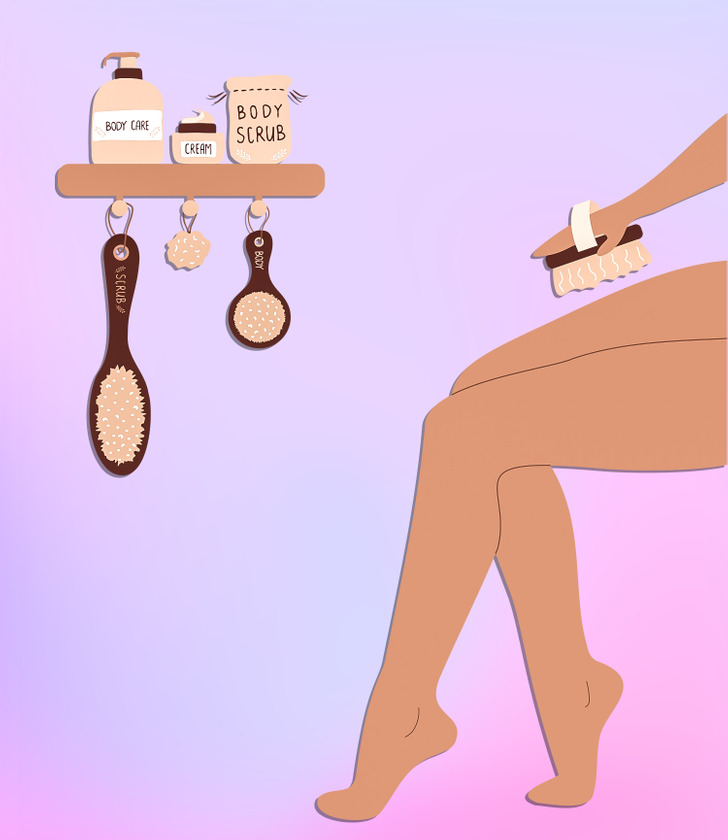The 20 Hottest Men in the World According to Ordinary People, Not Glossy Magazines


Like every part of our inner and outer body needs attention, our legs require time and work too. Especially during the summer months when we expose our skin to the sun, we need to be extra careful. For example, you can’t forget to apply sunscreen or drink a lot of water, since your legs will get sunburnt and dry. There are also other tips and tricks that will benefit your legs and skin, not only during the summer but all year long.
But it’s only our the sun that can harm our beautiful legs and make them feel the exact opposite of smooth. Shaving is also an area where women often traumatize their skin and use methods that make them look dry. And because many of you are probably making these mistakes, we thought it would be helpful to indicate some ways that can make your legs and skin feel and be radiant.

Since the wrong shaving technique is one of the reasons for the appearance of red bumps on the legs, it’s important to remember a few rules on how to avoid this irritation.

Our skin naturally sheds dead skin cells every 30 days. Sometimes, dead skin cells don’t shed completely, resulting in dry, flaky patches and clogged pores. Getting rid of dead skin cells is called exfoliating.

For calf cramps:
✅ Stand about 2-2.5 feet from a wall, lean forward into the wall, and place your forearms against it. Keeping your knees and back straight and your feet on the floor, gently stretch your calf muscles.
✅ If the pain isn’t unbearable, you can try walking around on your heels.
✅ Lunge forward with your leg that isn’t cramped. Keeping the cramped leg straight, gently stretch your calf.
✅ While lying and keeping your cramped leg as straight as possible, pull your toes up toward your knee.

The size of your talus is really the key to finding suitable heels for you. The talus is the bone in the lower part of the ankle joint that helps your foot move up and down. The way it moves determines the height you can wear. This means that some women are better built for wearing heels than others.
To check how far your talus can stretch, hold your leg out straight and relax your foot. If your talus goes downward, it means your foot is rather flexible and it won’t be a problem for you to wear high heels. If it doesn’t tilt, then you might feel more comfortable in flatter shoes since they don’t require a lot of movement from the foot and provide a right angle to the ground.

Moisturize your legs regularly — especially after shaving them — to replenish the skin’s moisture. It’s better to opt for moisturizers that don’t contain preservatives to avoid any possible side effects, like stinging.

Dry brushing your legs is essential to accelerate blood circulation and remove dead skin cells. You can do it in an upward direction starting at the soles of your feet or ankles. Start with soft, circular motions and then move on to longer strokes. In some situations, brushing needs to be avoided, like near rashes, wounds, etc.



Among the many benefits of this Ayurvedic technique, are an increase in your blood circulation and lymphatic drainage in your legs. Our blood carries lymph fluid which is filtered through the lymph nodes. When we follow this technique correctly, we speed up the pumping of blood which also helps to get the lymph through the body and remove toxins and pathogens.
Steps to effectively dry brush your legs:
1. Get a firm, natural-bristle brush.
2. It’s better to do it right before you have a bath, and more convenient because you’ll need to remove your clothes.
3. Start at your ankle and slowly move up in a circular motion.
4. Dry brush your legs, going up to the upper thighs. It should take about five minutes per leg.
5. Be careful about the amount of pressure you apply. It should be firm but not so much that it hurts.
6. When you finish, you can have a shower or bath, and then apply some lotion or body oil on your legs.

At the end of the day, there’s nothing better than to take a long relaxing bath. But if you want to take it to the next level: get some epsom salts. They contain a chemical compound called magnesium sulfate. Experts claim that its deficiency can contribute to increased inflammation and chronic conditions.
When we soak in the tub, the magnesium can be absorbed through the skin and thus we elevate our levels of magnesium. When you’re drawing your bath, measure 2 cups of epsom salt per gallon of water. Soak in and enjoy!

Before you get up:
1. Ankle pumping: While you’re lying on your back with your legs stretched, flex your feet moving your toes up and down. Repeat at least 10 times.
2. Knee bends: After you finish this exercise, with your legs still stretched, move alternatively your knees up to your chest and then back down. Repeat ten times with each leg.
3. Leg lifts: While you’re still lying on your back, bend one knee with the sole of your foot firmly on a flat surface. Raise your other leg without bending it until both knees are at the same level. Do this 10 times and then repeat with the other leg.
During the day:
If you’ve been sitting for too long at your desk, bear in mind your posture. Avoid crossing your legs for too long and when you take a break, try to do the following exercises:
1. Heel lifts: While holding onto a chair, raise your heels slowly until you’re standing on tiptoes. Lower your heels until they touch the ground. Repeat 10 times.
2. Leg stands: While holding onto a chair, leave one foot firmly grounded on the floor and lift the other one. Hold this position for 15 seconds and then repeat with the other leg. Try to gradually increase the time you hold this position.
Pumice is a good option when we need to remove dry skin and soften the calluses. To make the process safe, keep the feet and the pumice in warm water for 5-10 minutes. Then, dry the feet but not the pumice and keep massaging the skin for 2-3 minutes. After the procedure, wash the pumice and put some moisturizing cream on the feet.
Epilators remove hair with their roots from your legs. If you do it wrong, the device will cut the hair instead of pulling them out. To avoid this, exfoliate and use the device the correct way. Hold it at a 90-degree angle and slowly move it pressing on the skin lightly.
Big calluses can make you feel uncomfortable but don’t buy special creams or ask a beauty salon worker to help you with them. It’s better to see an actual doctor and get their professional care. They will polish the area and find out the reason why you have calluses. Some people have calluses because of how their feet are built and only a doctor can help in such a situation.

In addition to improving your digestion and keeping your heart happy, cabbage can relieve the unpleasant sensation of swollen feet. Get some cabbage leaves and chill in the fridge and wrap them around the swollen area. Repeat this until you feel better. Because cabbage draws out excess fluid, it serves as a natural and easily affordable way to reduce swelling.
Do you have any struggles regarding your skin and legs? If so, what is it that makes them look not so great and what changes do you think you should make in order for them to start looking better?











